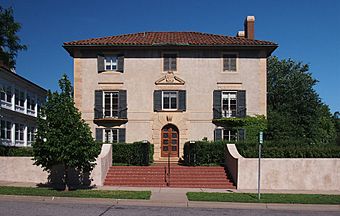Elizabeth C. Quinlan House facts for kids
Quick facts for kids |
|
|
Elizabeth C. Quinlan House
|
|

Elizabeth C. Quinlan House, 2014
|
|
| Lua error in Module:Location_map at line 420: attempt to index field 'wikibase' (a nil value). | |
| Location | 1711 Emerson Ave S, Minneapolis, Minnesota |
|---|---|
| Area | less than one acre |
| Built | 1925 |
| Architect | Frederick L. Ackerman |
| Architectural style | Renaissance Revival |
| NRHP reference No. | 12000428 |
| Added to NRHP | July 25, 2012 |
The Elizabeth C. Quinlan House is a special old home in the Lowry Hill neighborhood of Minneapolis, Minnesota. It was built in 1925 for Elizabeth Quinlan. The house has a unique style called eclectic Renaissance Revival. A famous architect named Frederick L. Ackerman designed it.
Elizabeth Quinlan was a very successful businesswoman. She helped start one of the first clothing stores for women in Minneapolis way back in 1894. Her business grew a lot, and she became well-known in the fashion world.
Contents
About the Quinlan House
This house cost about $47,000 to build in 1925. That would be a lot more money today! It has an "L" shape and is three stories tall.
Cool Features of the House
The Elizabeth C. Quinlan House has many interesting details. Its walls are made of stucco, which is a type of plaster. It also has special corner stones called quoining. The roof is made of terra cotta, which are clay tiles. You can also see beautiful ironwork on the house. Some of this fancy ironwork was made by a famous artist named Samuel Yellin.
Designed by a Famous Architect
The architect, Frederick L. Ackerman, also designed Elizabeth Quinlan's store. This store was called the Young–Quinlan Building. It was built one year after her house, in 1926. Both the house and the store share a similar architectural style. This shows how talented Ackerman was.
History of the House
Elizabeth Quinlan lived in this beautiful home from 1925 until she passed away in 1947. After her death, the house stayed in her family. It is still a privately owned home today.
A Historic Landmark
In 2012, the Elizabeth C. Quinlan House was added to the National Register of Historic Places. This means it is recognized as an important historic building. It's a great example of the eclectic architectural style from the 1920s. It also shows off the amazing work of Frederick Ackerman.

